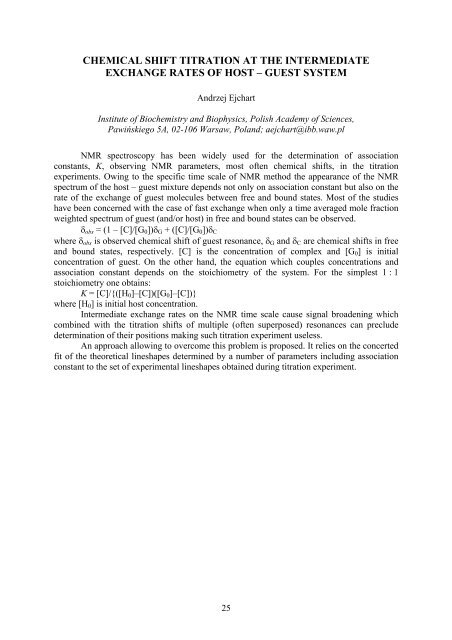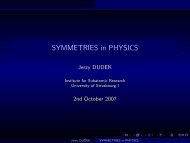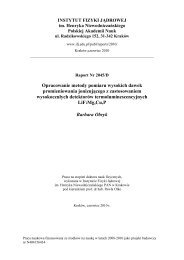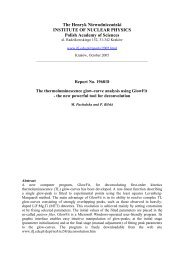Report No xxxx - Instytut Fizyki JÄ drowej PAN
Report No xxxx - Instytut Fizyki JÄ drowej PAN
Report No xxxx - Instytut Fizyki JÄ drowej PAN
You also want an ePaper? Increase the reach of your titles
YUMPU automatically turns print PDFs into web optimized ePapers that Google loves.
CHEMICAL SHIFT TITRATION AT THE INTERMEDIATE<br />
EXCHANGE RATES OF HOST – GUEST SYSTEM<br />
Andrzej Ejchart<br />
Institute of Biochemistry and Biophysics, Polish Academy of Sciences,<br />
Pawińskiego 5A, 02-106 Warsaw, Poland; aejchart@ibb.waw.pl<br />
NMR spectroscopy has been widely used for the determination of association<br />
constants, K, observing NMR parameters, most often chemical shifts, in the titration<br />
experiments. Owing to the specific time scale of NMR method the appearance of the NMR<br />
spectrum of the host – guest mixture depends not only on association constant but also on the<br />
rate of the exchange of guest molecules between free and bound states. Most of the studies<br />
have been concerned with the case of fast exchange when only a time averaged mole fraction<br />
weighted spectrum of guest (and/or host) in free and bound states can be observed.<br />
δ obs = (1 – [C]/[G 0 ])δ G + ([C]/[G 0 ])δ C<br />
where δ obs is observed chemical shift of guest resonance, δ G and δ C are chemical shifts in free<br />
and bound states, respectively. [C] is the concentration of complex and [G 0 ] is initial<br />
concentration of guest. On the other hand, the equation which couples concentrations and<br />
association constant depends on the stoichiometry of the system. For the simplest 1 : 1<br />
stoichiometry one obtains:<br />
K = [C]/{([H 0 ]–[C])([G 0 ]–[C])}<br />
where [H 0 ] is initial host concentration.<br />
Intermediate exchange rates on the NMR time scale cause signal broadening which<br />
combined with the titration shifts of multiple (often superposed) resonances can preclude<br />
determination of their positions making such titration experiment useless.<br />
An approach allowing to overcome this problem is proposed. It relies on the concerted<br />
fit of the theoretical lineshapes determined by a number of parameters including association<br />
constant to the set of experimental lineshapes obtained during titration experiment.<br />
25

















